Hey everyone,
Every year, I get a little excited as I wonder what new products will be brought out by Meguiar’s. Being one of the original reviewers of the original Meguiar’s G-110 Dual Action Polisher, I was very interested in the changes Meguiar’s made to this polisher in its now NEW G-110 V2 form.
Last Fall around the end of November I received my G110 V2 for product testing and for review. When I first opened up the box, the first thing I noticed is that the black molded plastic case that came with the original G110 was replaced with a much more useful canvas tote bag. I never did understand why the original G110 came in a product molded plastic box because as soon as you attached the bail handle to the polisher, it no longer fit into the case. The tote bag changes all that as to me it is far more useful!


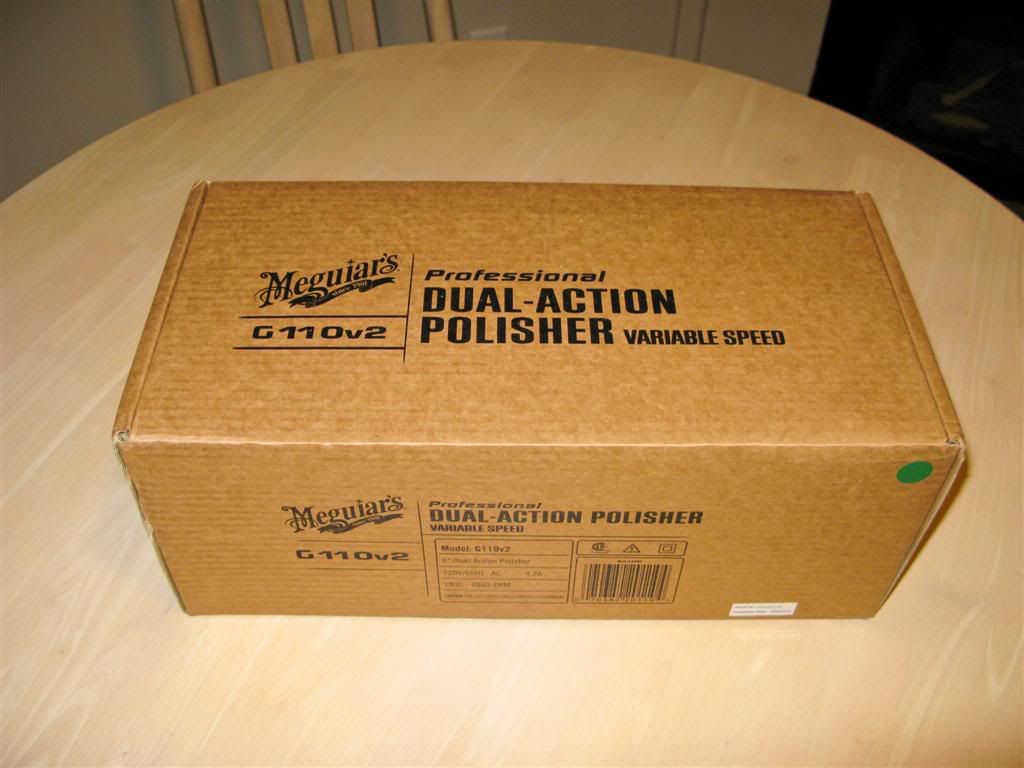

The new G110 V2 comes nicely boxed in a protective Styrofoam container with the W-68DA backing plate and other accessories inside of the remainder of the cardboard box. The new G110 V2 uses an identical bail handle that was used with the original G110. One word of advice make sure to tighten the 6 mm Allen bolts holding the handle to the polisher often if you tend to rotate the handle into different positions depending on what body panel or angle you are working at. While many people, including myself, remove the handle and on the Meguiar’s G100 and the Porter Cable (PC) 7424, 7335 (G100) and 7336 etc, I find that the bail handle on the G110 actually allows me better leverage when working on awkward panels. It comes down to a personal choice, but if you do use it, do check the bolt’s tightness once in a while!
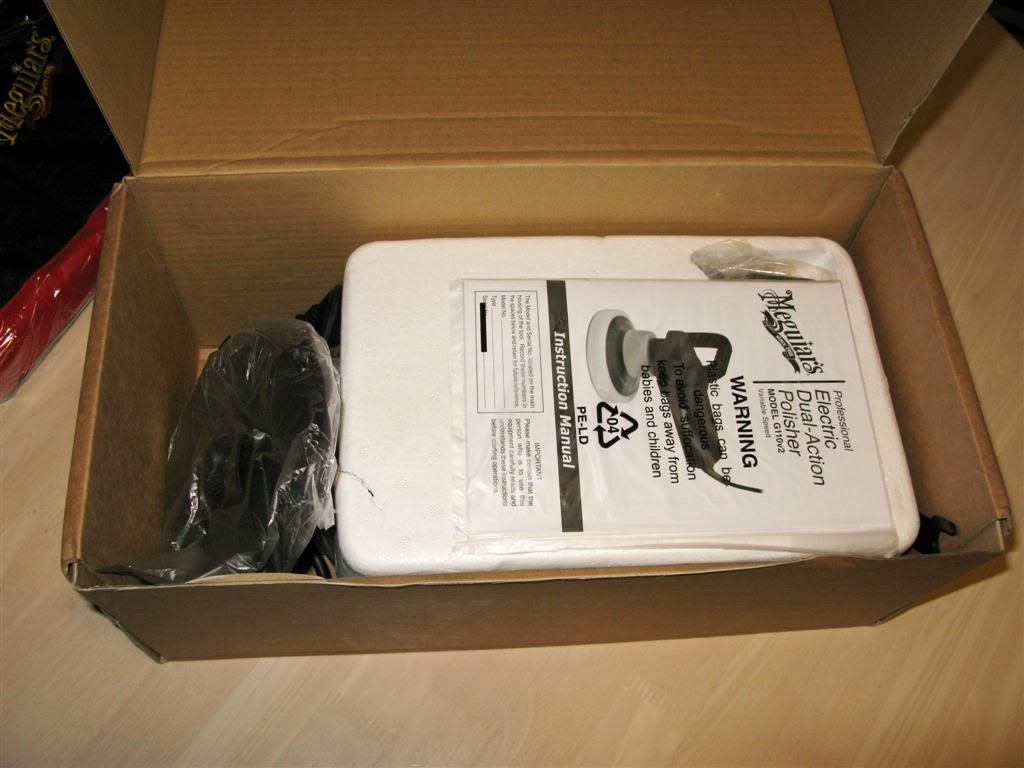
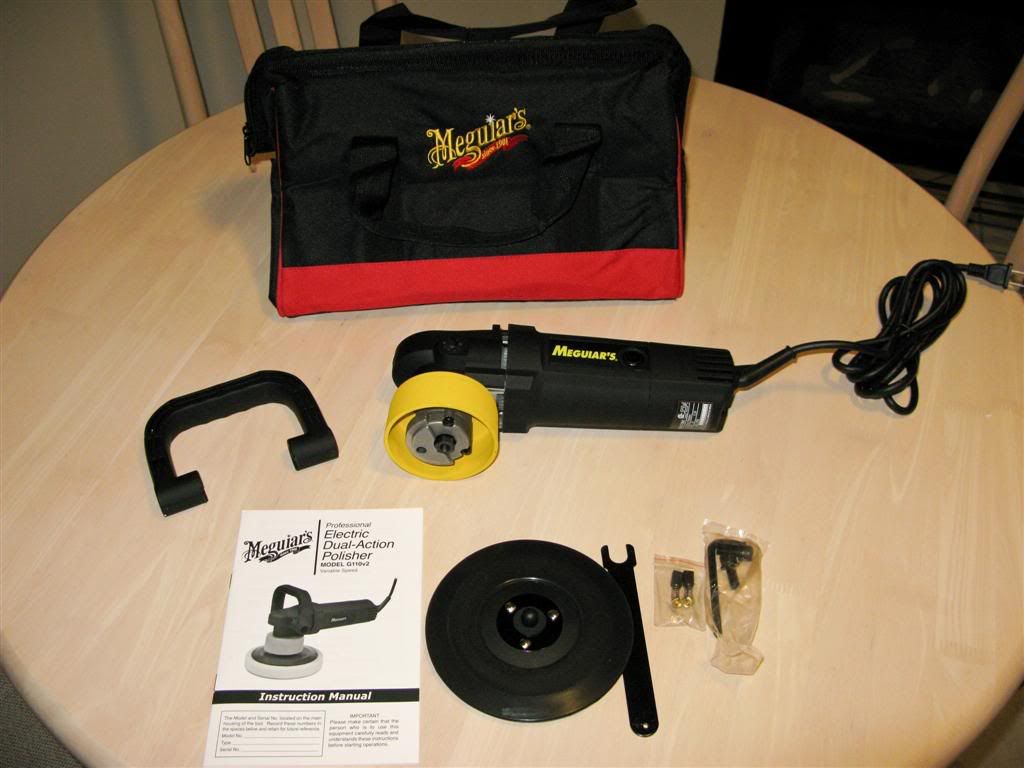

When I looked at the new polisher, the first thing that stood out to me was a little access panel on the side of the polisher so you can change the brushes when they wear out. This new feature is indeed very worthwhile as you are able to change to new brushes (which an extra set is supplied) by using a slot screwdriver. On the old G110, you had to remove the rear cover, find a very tiny torx head driver in order to remove the old brushes. Please be advised that opening the case on the polisher will possibly void your warranty, so keep that in mind if you decide to venture inside the polisher. Not to mention, the old G110 did not come with user replaceable brushes which usually meant taking it to a service center. The new design changes that aspect!
The second thing that stood out is the length of the new polisher. The new G110 V2 is quite a bit longer than the old version and it also has a smaller protective shroud for the counter weight than the older version. The smaller shroud makes polishing paint under side mirrors easier as it allows more accessibility. The additional length to the polisher is to accommodate a new feature called Cruise Control which uses an internal feedback circuit that increases torque when it senses that extra power is required due to downward pressure on the polisher.
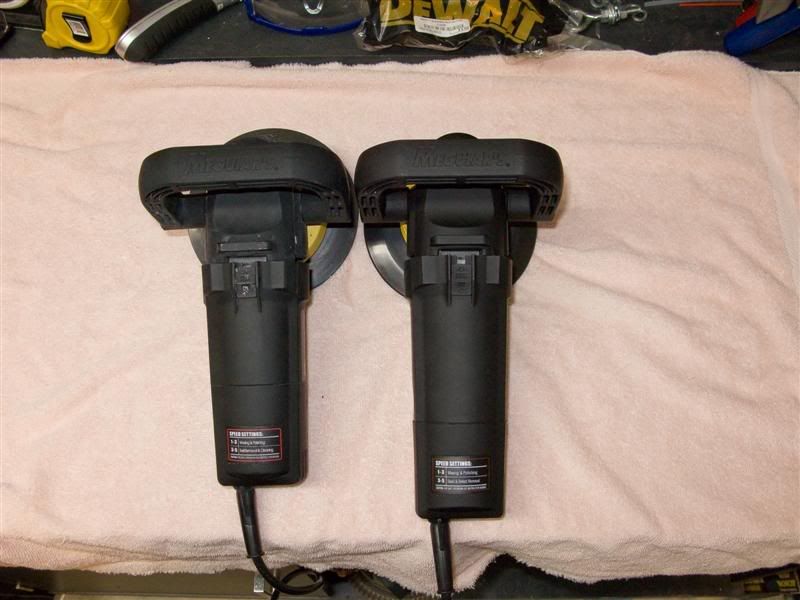
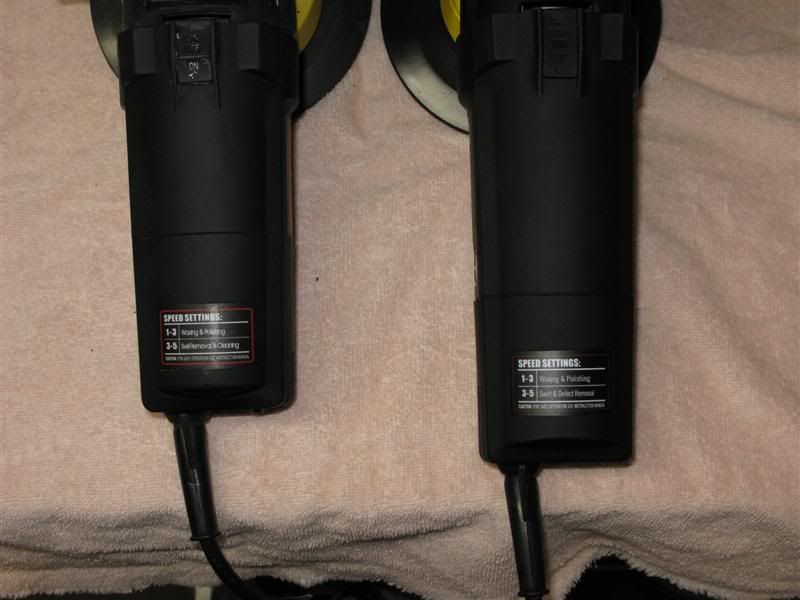

Thirdly, the new G110 V2 utilizes a 'soft start' feature when the polisher starts up. Instead of the polisher accelerating to full speed as soon as it is switched on, it gradually “ramps-up” to speed. Though I am not sure of the reasoning behind it exactly, it does seem to me that it is being used in order to prevent a massive power surge from occurring through the switch, thereby maximizing the tools longevity from start-up wear and tear. Again, I am only speculating, but it seems quite plausible. In audio systems, high powered amplifiers often use a soft start circuit so the power comes on gradually at start-up so that it does not blow circuit breakers from the large surge. Again, I am only speculating on the G110 V2…
Finally, there is a significant speed increase [Corrected for mistake in information. Tim ] on the G110 V2 with the 6 speed settings the opm’s have been changed to 1800-6800 OPM, spread over a wider and more powerful power-band. What that means to most is that while speed 5 is still the highest recommended setting, there is more power at that setting. More power means better paint correction and the less likelihood that one would be tempted to go into the speed-6 territory where damage to pads and the backing plate is possible. But herein lays one of the few negatives that I do have with this new polisher.
] on the G110 V2 with the 6 speed settings the opm’s have been changed to 1800-6800 OPM, spread over a wider and more powerful power-band. What that means to most is that while speed 5 is still the highest recommended setting, there is more power at that setting. More power means better paint correction and the less likelihood that one would be tempted to go into the speed-6 territory where damage to pads and the backing plate is possible. But herein lays one of the few negatives that I do have with this new polisher.
The speed selector switch on the new G110 V2 does not have physical detents/notches for each speed being selected like the original G110 or any of the PC (Porter Cable) DA polishers. To me, I tend to adjust speed on the fly as the situation requires. Because you are supposed to start and stop the DA polisher on the paint’s surface (this is to avoid having the buffing pad fly off the backing plate due to the oscillating action of the polisher), you can not change speeds without first stopping the polisher, making the changes and then back to buffing again. I find that very inconvenient, mostly because I have gotten used to the other polishers over many many years. For someone somewhat new to DA polisher, this may not be a big issue, but for others it is something to be aware of.
The second issue, though minor are the painted numbers, on the above speed selector switch. I find that the numbers are very difficult to see in low light. In a dimly lit garage, speed-5 is difficult to see. The original G110 and the PC all have very visible numbers. Again, while a minor issue, it is something that again stands out to me having used many other DA’s.
Here is the new G110 V2 selector switch:

And here is the original G110 switch:
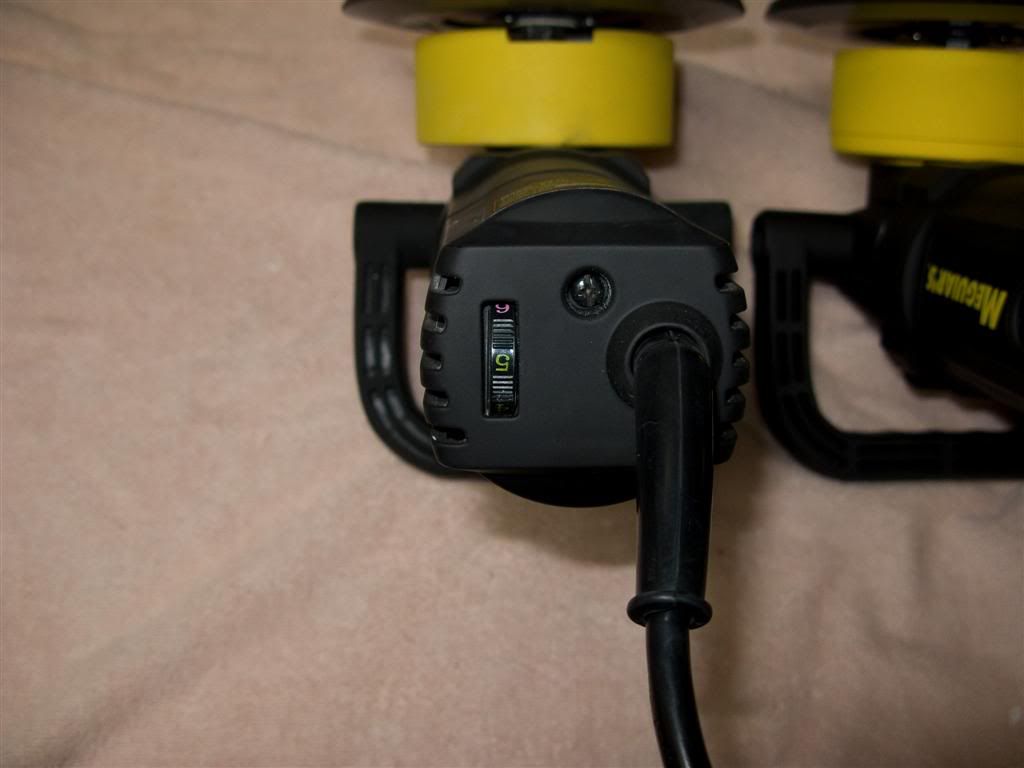
Just to be clear, the minor issues above are just that…minor. However, one would have thought that those minor differences would have been discovered during the beta testing stage. Perhaps they were and these changes were made on purpose for a reason I am not aware of. But either way, in the spirit of writing an accurate review, I mention these so that people are at least aware of the changes.
But either way, in the spirit of writing an accurate review, I mention these so that people are at least aware of the changes.
With the above minor quibbles aside, so what do these changes on paper actually change in practice? A lot actually! With the G110 V2, the increase in power is very noticeable! While I do not hear a change in power/speed that others have heard due to the feedback circuit, I have noticed that while the old version would bog down when a moderate amount of pressure is being applied, the new G110 V2 just keeps on spinning! In fact, I placed so much pressure on to the polisher that any more exertion placed upon it could have damaged the body panel. The panel was already flexing far more than I like! Of course I could still bog it down, but it was far more difficult to do so, than compared to the original G110. This increased torque means the new G110 V2 has a better ability to do paint correction, before moving on to a more aggressive method, like using a rotary polisher.
With the G110 V2, the increase in power is very noticeable! While I do not hear a change in power/speed that others have heard due to the feedback circuit, I have noticed that while the old version would bog down when a moderate amount of pressure is being applied, the new G110 V2 just keeps on spinning! In fact, I placed so much pressure on to the polisher that any more exertion placed upon it could have damaged the body panel. The panel was already flexing far more than I like! Of course I could still bog it down, but it was far more difficult to do so, than compared to the original G110. This increased torque means the new G110 V2 has a better ability to do paint correction, before moving on to a more aggressive method, like using a rotary polisher.
Now I am not saying that it will correct all paints, because it won’t. What makes it so safe, also makes it less aggressive. But for the beginner, the G110 V2’s action is safe, removing most of the risk of burning paint, unlike what a rotary can do in the hands of the inexperienced. For the professional who makes a living out detailing, having a DA polisher which has the ability to do more paint correction without resorting to a rotary polisher means more can be done in fewer steps, and without the risk of rotary holograms! This translates into a large time saver and as everyone knows, time is money! So while the increase in power seems small, it is very beneficial overall!
So, is the G110 V2 a huge improvement over the original G110? Well that depends. Do both versions allow people to do minor to moderate paint correction….yes, they both do. However, with the added performance, and the consumer replaceable brushes, makes the new G110 V2 a worthy and beneficial upgrade for those with the original version and a fantastic machine for those just starting out. It balances power with safety, making it one of the most useful tools in the detailer’s arsenal!!!
I hope this helps!
Tim
Every year, I get a little excited as I wonder what new products will be brought out by Meguiar’s. Being one of the original reviewers of the original Meguiar’s G-110 Dual Action Polisher, I was very interested in the changes Meguiar’s made to this polisher in its now NEW G-110 V2 form.
Last Fall around the end of November I received my G110 V2 for product testing and for review. When I first opened up the box, the first thing I noticed is that the black molded plastic case that came with the original G110 was replaced with a much more useful canvas tote bag. I never did understand why the original G110 came in a product molded plastic box because as soon as you attached the bail handle to the polisher, it no longer fit into the case. The tote bag changes all that as to me it is far more useful!





The new G110 V2 comes nicely boxed in a protective Styrofoam container with the W-68DA backing plate and other accessories inside of the remainder of the cardboard box. The new G110 V2 uses an identical bail handle that was used with the original G110. One word of advice make sure to tighten the 6 mm Allen bolts holding the handle to the polisher often if you tend to rotate the handle into different positions depending on what body panel or angle you are working at. While many people, including myself, remove the handle and on the Meguiar’s G100 and the Porter Cable (PC) 7424, 7335 (G100) and 7336 etc, I find that the bail handle on the G110 actually allows me better leverage when working on awkward panels. It comes down to a personal choice, but if you do use it, do check the bolt’s tightness once in a while!




When I looked at the new polisher, the first thing that stood out to me was a little access panel on the side of the polisher so you can change the brushes when they wear out. This new feature is indeed very worthwhile as you are able to change to new brushes (which an extra set is supplied) by using a slot screwdriver. On the old G110, you had to remove the rear cover, find a very tiny torx head driver in order to remove the old brushes. Please be advised that opening the case on the polisher will possibly void your warranty, so keep that in mind if you decide to venture inside the polisher. Not to mention, the old G110 did not come with user replaceable brushes which usually meant taking it to a service center. The new design changes that aspect!
The second thing that stood out is the length of the new polisher. The new G110 V2 is quite a bit longer than the old version and it also has a smaller protective shroud for the counter weight than the older version. The smaller shroud makes polishing paint under side mirrors easier as it allows more accessibility. The additional length to the polisher is to accommodate a new feature called Cruise Control which uses an internal feedback circuit that increases torque when it senses that extra power is required due to downward pressure on the polisher.



Thirdly, the new G110 V2 utilizes a 'soft start' feature when the polisher starts up. Instead of the polisher accelerating to full speed as soon as it is switched on, it gradually “ramps-up” to speed. Though I am not sure of the reasoning behind it exactly, it does seem to me that it is being used in order to prevent a massive power surge from occurring through the switch, thereby maximizing the tools longevity from start-up wear and tear. Again, I am only speculating, but it seems quite plausible. In audio systems, high powered amplifiers often use a soft start circuit so the power comes on gradually at start-up so that it does not blow circuit breakers from the large surge. Again, I am only speculating on the G110 V2…
Finally, there is a significant speed increase [Corrected for mistake in information. Tim
 ] on the G110 V2 with the 6 speed settings the opm’s have been changed to 1800-6800 OPM, spread over a wider and more powerful power-band. What that means to most is that while speed 5 is still the highest recommended setting, there is more power at that setting. More power means better paint correction and the less likelihood that one would be tempted to go into the speed-6 territory where damage to pads and the backing plate is possible. But herein lays one of the few negatives that I do have with this new polisher.
] on the G110 V2 with the 6 speed settings the opm’s have been changed to 1800-6800 OPM, spread over a wider and more powerful power-band. What that means to most is that while speed 5 is still the highest recommended setting, there is more power at that setting. More power means better paint correction and the less likelihood that one would be tempted to go into the speed-6 territory where damage to pads and the backing plate is possible. But herein lays one of the few negatives that I do have with this new polisher.The speed selector switch on the new G110 V2 does not have physical detents/notches for each speed being selected like the original G110 or any of the PC (Porter Cable) DA polishers. To me, I tend to adjust speed on the fly as the situation requires. Because you are supposed to start and stop the DA polisher on the paint’s surface (this is to avoid having the buffing pad fly off the backing plate due to the oscillating action of the polisher), you can not change speeds without first stopping the polisher, making the changes and then back to buffing again. I find that very inconvenient, mostly because I have gotten used to the other polishers over many many years. For someone somewhat new to DA polisher, this may not be a big issue, but for others it is something to be aware of.
The second issue, though minor are the painted numbers, on the above speed selector switch. I find that the numbers are very difficult to see in low light. In a dimly lit garage, speed-5 is difficult to see. The original G110 and the PC all have very visible numbers. Again, while a minor issue, it is something that again stands out to me having used many other DA’s.
Here is the new G110 V2 selector switch:

And here is the original G110 switch:

Just to be clear, the minor issues above are just that…minor. However, one would have thought that those minor differences would have been discovered during the beta testing stage. Perhaps they were and these changes were made on purpose for a reason I am not aware of.
 But either way, in the spirit of writing an accurate review, I mention these so that people are at least aware of the changes.
But either way, in the spirit of writing an accurate review, I mention these so that people are at least aware of the changes. With the above minor quibbles aside, so what do these changes on paper actually change in practice? A lot actually!
 With the G110 V2, the increase in power is very noticeable! While I do not hear a change in power/speed that others have heard due to the feedback circuit, I have noticed that while the old version would bog down when a moderate amount of pressure is being applied, the new G110 V2 just keeps on spinning! In fact, I placed so much pressure on to the polisher that any more exertion placed upon it could have damaged the body panel. The panel was already flexing far more than I like! Of course I could still bog it down, but it was far more difficult to do so, than compared to the original G110. This increased torque means the new G110 V2 has a better ability to do paint correction, before moving on to a more aggressive method, like using a rotary polisher.
With the G110 V2, the increase in power is very noticeable! While I do not hear a change in power/speed that others have heard due to the feedback circuit, I have noticed that while the old version would bog down when a moderate amount of pressure is being applied, the new G110 V2 just keeps on spinning! In fact, I placed so much pressure on to the polisher that any more exertion placed upon it could have damaged the body panel. The panel was already flexing far more than I like! Of course I could still bog it down, but it was far more difficult to do so, than compared to the original G110. This increased torque means the new G110 V2 has a better ability to do paint correction, before moving on to a more aggressive method, like using a rotary polisher. Now I am not saying that it will correct all paints, because it won’t. What makes it so safe, also makes it less aggressive. But for the beginner, the G110 V2’s action is safe, removing most of the risk of burning paint, unlike what a rotary can do in the hands of the inexperienced. For the professional who makes a living out detailing, having a DA polisher which has the ability to do more paint correction without resorting to a rotary polisher means more can be done in fewer steps, and without the risk of rotary holograms! This translates into a large time saver and as everyone knows, time is money! So while the increase in power seems small, it is very beneficial overall!

So, is the G110 V2 a huge improvement over the original G110? Well that depends. Do both versions allow people to do minor to moderate paint correction….yes, they both do. However, with the added performance, and the consumer replaceable brushes, makes the new G110 V2 a worthy and beneficial upgrade for those with the original version and a fantastic machine for those just starting out. It balances power with safety, making it one of the most useful tools in the detailer’s arsenal!!!
I hope this helps!

Tim





 Man...I must be getting old!
Man...I must be getting old! 


Comment